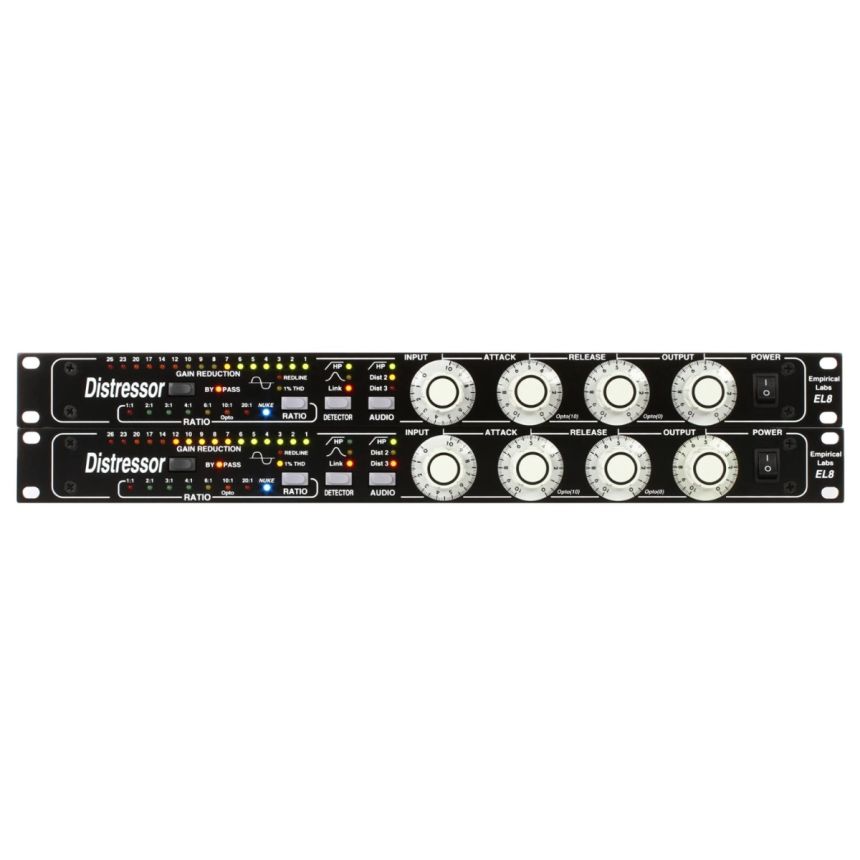Empirical Labs EL8-S Distressor
Classic Compression in a Stereo Pair!
The four large white knobs gleam at you as you enter the control room, announcing that this is not going to be your ordinary dynamics processing session. Vintage compressors are coveted — and rightly so — for their sonic qualities, but if there's a modern analog unit that belongs in the pantheon of all-time-great dynamics processors, it's the Empirical Labs EL8 Distressor. Which leads to the question: what do George Massenburg, Bob Clearmountain, Steve Vai, and Mick Gazouski have in common? They're all in the Distressor early-adopters club. Former Eventide engineer Dave Derr's ground-breaking design, released in 1996, has to be the most sui generis compressor we've come across.
The bee's knees
As the rest of the audio world caught on, the Distressor found a home in studios racks worldwide, alongside the venerable classics that were inspirational in its design. Rave reviews ensued, with enthusiastic users reporting elevated levels of elation (hence the "EL8" in the product name). Empirical Labs somewhat understates the Distressor's sonic alchemy as "digitally-controlled analog knee compression." At Sweetwater, we call it indispensable.
Hundreds of options with just a few control settings
The Distressor lets you add 2nd or 3rd order harmonic distortion to the signal, emulating tape saturation and the classic tube compressor sound of the 1960s and '70s. It also offers advanced sidechain EQ, eight unique curves, and Empirical Labs' exclusive "Binary Stepped Interface," providing hundreds of options with just a few control settings. Beyond its broad control and feature set, the Distressor's custom-designed gain control circuit delivers a warm vintage-flavored sound that is the perfect Rx for the unforgiving nature of modern digital recording. When you consider that the tube equipment, analog tape, and vinyl records of yesteryear could not help but color sound (often to the chagrin of recording engineers), the Distressor offers the best of both worlds: selective, controllable coloration.
It's like having several different dynamics processors in one
From its gently warming 1:1 setting with low-order harmonics but no compression, to the brutal brick-wall limiting of Nuke mode, the Distressor's eight curves give you a world of sound-shaping options. You haven't lived until you've heard Nuke mode on live drum room mics. Explosive! Each curve offers its own sonic personality — and some actually use different circuitry, making them, effectively, different compressors. Most notably, the 10:1 Opto setting employs separate detector circuitry to emulate classic "light-controlled" compressors.
Power and personality
A major part of the Distressor's power and personality are its three coloration modes that work independently of compression. Designed to emulate coveted vintage compressors and limiters, these modes allow the Distressor to deliver a classic "knee" sound all its own by providing warm-sounding, user-programmable harmonic distortion. In addition to the EL8's basic distortion mode, Distort 2 emphasizes tube-like Class A 2nd-order harmonics; Distort 3 distortion is dominated by 3rd-order harmonics that gradually flatten out the top and bottom of the waveform; similar to recording on magnetic tape. Two highpass filters — one in the audio path, another in the detector path — are also on deck to curtail low frequencies that may cause breathing and pumping higher in the spectrum.
Desert-island contender
The Distressor is perhaps most often employed to beef up bass lines, snare, and kick drums; but it's a fiendishly capable beast that can add aggressive, in-your-face energy and excitement to synths, guitars, vocals, or pretty much anything else you care to feed it. And with its stereo linking capabilities, it can work wonders in the mastering suite or strapped across a drum bus. It's nearly impossible to make this thing sound bad. Don't be intimidated by the fact that there are 384 possible settings (not including the knobs) — setting the ratio at 6:1 and all four knobs around 5 or 6 will get you up and running fast. With its vast sound-sculpting power and versatility, the Empirical Labs EL8 Distressor is a modern classic compressor that may well belong on your list of desert-island gear.
Empirical Labs EL8 Distressor Stereo Pair Features:
- Classic "knee" compression with modern specs and performance
- Programmable analog distortion warms up unforgiving digital recordings
- Three audio modes: user-programmable, vintage-style harmonic distortion
- Clean and Distort 2 modes: tube-like, 2nd-order harmonics
- Distort 3 modes: distortion dominated by 3rd-order harmonics (similar to tape)
- Distortion indicator lights: 1% LED, "Redline" (3%) LED; hard clipping starts a few dB past "Redline"
- Advanced sidechain EQ: high-mid band emphasis tames harsh, edgy signals; highpass keeps the low sum/difference frequencies from pumping source material's upper frequencies
- Eight unique curves, starting with 1:1 with low-order harmonics but no compression
- "Nuke" setting is a brick-wall limiting curve — great for drum room mics
- 10:1 Opto setting employs separate detector circuitry to emulate classic "light-controlled" compressors
- Discrete and integrated circuitry for the best combination of speed/linearity with repeatability
- Hand-selected and tested long-life components, including all-metal film and Roederstein resistors in audio path
- Large knobs with high-resolution numbering for easy readability and repeatable settings
- Locked and calibrated output level for confident, speedy setups
- Switchable 115/230 volt operation with extra fuse stored inside unit
- Over-designed power supply runs cool, allows for sealed cabinet without heat vents
- True bypass for confident A/B comparisons
- XLR and 1/4" I/O; stereo linkable
- Hand-wired and calibrated in USA





